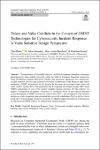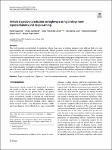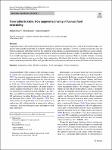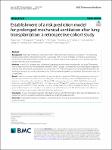Search
Author
- Osman, Ahmed I. (5)
- Daqing, Ma (3)
- Jorgensen, Ed (3)
- Li, Yan (3)
- next >
Subject
- kinh tế (26)
- Economics (12)
- programming (10)
- XRD (10)
- next >
Date issued
- 2020 - 2025 (2128)
- 2010 - 2019 (129)
- 2000 - 2009 (9)
- 1999 - 1999 (1)
Has File(s)
Search Results
The negotiation of stakeholder values as a collaborative process throughout technology development has been studied extensively within the fields of Computer Supported Cooperative Work and Human-Computer Interaction. Despite their increasing significance for cybersecurity incident response, there is a gap in research on values of importance to the design of open-source intelligence (OSINT) technologies for this purpose. In this paper, we investigate which values and value conflicts emerge due to the application and development of machine learning (ML) based OSINT technologies to assist cyber security incident response operators. |
‘Business Process Standardization’ (BPS) is a practice intended to achieve consistency across underlying organizational processes, in support of service-delivery excellence and optimization of costs and benefits. Given the growing importance of BPS, there is need in both research and practice for clearer conceptual understanding of the notion. Following a systematic literature review approach, prior work on Business Process Standardization is synthesized and extended using tool-supported qualitative data analysis techniques, to derive an evidence-based, holistic conceptualization of BPS. We distil seven stages of BPS execution, propose a refined definition for BPS, and identify measures that gauge the several conceptual themes of BPS. The findings provide solid theoretical foundatio... |
This work presents a novel method for predicting vehicle trajectories in highway scenarios using efficient bird’s eye view representations and convolutional neural networks. Vehicle positions, motion histories, road configuration, and vehicle interactions are easily included in the prediction model using basic visual representations. The U-net model has been selected as the prediction kernel to generate future visual representations of the scene using an image-to-image regression approach. |
Particle systems made up of interacting agents is a popular model used in a vast array of applications, not the least in biology where the agents can represent everything from single cells to animals in a herd. Usually, the particles are assumed to undergo some type of random movements, and a popular way to model this is by using Brownian motion. The magnitude of random motion is often quantified using mean squared displacement, which provides a simple estimate of the diffusion coefficient. However, this method often fails when data is sparse or interactions between agents frequent. |
This paper explores the relationship between an author's position in the bylines of an article and the research contributions they have made to analyze the validity of five bibliometric counting methods (arithmetic, fractional, geometric, harmonic, and harmonic parabolic author credit allocation) in the field of Chemical Biology. By classifying the tasks found in the author contribution statements of articles published in Nature Chemical Biology according to a three-tiered scheme, it was possible to divide the authors into three types: core-layer authors, middle-layer authors, and outer-layer authors. |
Τhe current paper examines the relationship between per capita health care expenditures, per capita CO2 emissions, and per capita gross domestic product (GDP) in G7 countries. At the beginning, we examine the cross-sectional dependence and the slope homogeneity between the countries. Then, the second-generation unit root test is applied using the Pesaran, CIPS (2007) test, while for the cointegration test, the Westerlund (Oxford Bulletin of Economics and Statistics 69(6):709-748, 2007) test was applied. The long -run panel cointegration coefficients were analyzed with the augmented mean group (AMG) estimators, which allow the cross-sectional dependence and heterogeneity. |
This textbook is an open educational resource with CC-BY licensing developed specifically for prelicensure nursing students. The e-book and downloadable versions are free. Affordable print versions are published in collaboration with XanEdu and available on Amazon and in college bookstores. Content is based on the Wisconsin Technical College System (WTCS) statewide nursing curriculum for the Nursing Mental Health and Community Concepts course (543-110), the NCLEX-RN Test Plan, 1 and the American Psychiatric Nurses Association Education Council’s Crosswalk Toolkit: Defining and Using Psychiatric-Mental Health Nursing Skills in Undergraduate Nursing Education. 2 Mental health and community health concepts are discussed while emphasizing stress management techniques, healthy coping str... |
Augmented reality (AR) technology has generated enormous industry investment and buzz, with the food and beverage sector quickly embracing this technology in an effort to enhance the customer experience. However, academic research has only just begun to empirically explore how and why this technology might influence consumer judgements and behaviors in such contexts. Across two field studies involving consequential behavior and two controlled laboratory studies, we find that AR’s unique ability to visually superimpose objects onto a real-time environment increases consumers’ ability to mentally simulate consuming a pictured food, which in turn increases their desire and purchase likelihood of the food item. Further, we find the increased mental simulation produced by AR is itself pr... |
The problem of selecting an algorithm that appears most suitable for a specific instance of an algorithmic problem class, such as the Boolean satisfiability problem, is called instance-specific algorithm selection. Over the past decade, the problem has received considerable attention, resulting in a number of different methods for algorithm selection. Although most of these methods are based on machine learning, surprisingly little work has been done on meta learning, that is, on taking advantage of the complementarity of existing algorithm selection methods in order to combine them into a single superior algorithm selector. In this paper, we introduce the problem of meta algorithm selection, which essentially asks for the best way to combine a given set of algorithm selectors. |
Prolonged mechanical ventilation (PMV), mostly defined as mechanical ventilation > 72 h after lung transplantation with or without tracheostomy, is associated with increased mortality. Nevertheless, the predictive factors of PMV after lung transplant remain unclear. The present study aimed to develop a novel scoring system to identify PMV after lung transplantation. |










